On this page
Darwin's FinchesThis page lists books about the Darwin's Finches of the Galapagos. The books are listed by publication date with the most recent at the top.
Darwin' Finches
There are thought to be 15 species of Darwin's Finches. Some sub-species are recognised. Fourteen of the species are endemic to the Galapagos islands. The Cocos Finch in endemic to Cocos Island. The 15 species are:
Large Cactus Finch
Geospiza conirostris
Sharp-beaked Ground Finch
Geospiza difficilis
Medium Ground Finch
Geospiza fortis
Small Ground Finch
Geospiza fuliginosa
Large Ground Finch
Geospiza magnirostris
Common Cactus Finch
Geospiza scandens
Vegetarian Finch
Camarhynchus crassirostris
Large Tree Finch
Camarhynchus psittacula
Medium Tree Finch
Camarhynchus pauper
Small Tree Finch
Camarhynchus parvulus
Woodpecker Finch
Camarhynchus pallidus
Mangrove Finch
Camarhynchus heliobates
Green Warbler-Finch
Certhidea olivacea
Grey Warbler-Finch
Certhidea fusca
Cocos Finch
Pinaroloxias inornata
|
|
|
|
40 Years of Evolution: Darwin's Finches on Daphne Major IslandPeter R. Grant and B. Rosemary Grant
Princeton University Press
2014
"Renowned evolutionary biologists Peter and Rosemary Grant have produced landmark studies of the Galápagos finches first made famous by Charles Darwin. In How and Why Species Multiply, they offered a complete evolutionary history of Darwin's finches since their origin almost 3 million years ago. Now, in their richly illustrated new book, 40 Years of Evolution, the authors turn their attention to events taking place on a contemporary scale. By continuously tracking finch populations over a period of four decades, they uncover the causes and consequences of significant events leading to evolutionary changes in species. The authors used a vast and unparalleled range of ecological, behavioral, and genetic data - including song recordings, DNA analyses, and feeding and breeding behavior – to measure changes in finch populations on the small island of Daphne Major in the Galápagos archipelago. They find that natural selection happens repeatedly, that finches hybridize and exchange genes rarely, and that they compete for scarce food in times of drought, with the remarkable result that the finch populations today differ significantly in average beak size and shape from those of forty years ago. The authors' most spectacular discovery is the initiation and establishment of a new lineage that now behaves as a new species, differing from others in size, song, and other characteristics. The authors emphasize the immeasurable value of continuous long-term studies of natural populations and of critical opportunities for detecting and understanding rare but significant events."
|
Buy from amazon.co.uk 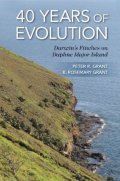
|
|
Darwin's Finches: Readings in the Evolution of a Scientific ParadigmEditor: Kathleen Donohue
University of Chicago Press
2011
"Two species come to mind when one thinks of the Galapagos Islands - the giant tortoises and Darwin's fabled finches. While not as immediately captivating as the tortoises, these little brown songbirds and their beaks have become one of the most familiar and charismatic research systems in biology, providing generations of natural historians and scientists a lens through which to view the evolutionary process and its role in morphological differentiation. In "Darwin's Finches", Kathleen Donohue excerpts and collects the most illuminating and scientifically significant writings on the finches of the Galapagos to teach the fundamental principles of evolutionary theory and to provide a historical record of scientific debate. Beginning with fragments of Darwin's Galapagos field notes and subsequent correspondence, and moving through the writings of such famed field biologists as David Lack and Peter and Rosemary Grant, the collection demonstrates how scientific processes have changed over time, how different branches of biology relate to one another, and how they all relate to evolution. As Donohue notes, practicing science today is like entering a conversation that has been in progress for a long, long time. Her book provides the history of that conversation and an invitation to join in."
|
Buy from amazon.co.uk 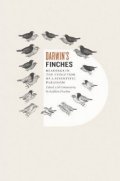
|
|
Treasures of the Natural History MuseumVicky Paterson
Natural History Museum
2009
"The Natural History Museum, London is home to one of the world's most important and comprehensive collections of natural history specimens, literature and artworks. Treasures of the Natural History Museum is a celebration of over 200 of the Museum's most exceptional natural history objects including world-famous specimens and little-known curiosities. Among the many natural wonders featured are: a rare meteorite from Mars; Darwin's celebrated finch specimens; a lethal claw from the dinosaur Baryonyx; and some immaculately dressed fleas. The treasures are selected both from objects on display and those stored behind the scenes; some are familiar and some never seen by the public before. Each one is chosen for its scientific importance, striking beauty or intriguing story, and sometimes all three. Discover a tiny snail no bigger than a letter on this page and one of the first signs of life on Earth in the form of a 3.5 billion-year-old fossil. The book also includes the magnificent 200-year-old Museum building itself with its many architectural treasures. With striking photographs and intriguing stories throughout, this is a fascinating insight into the best of the Museum's unrivalled collection."
|
Buy from amazon.co.uk 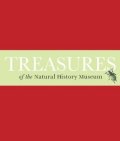
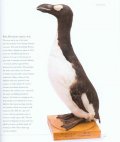
|
|
How and Why Species Multiply: The Radiation of Darwin's FinchesPeter R. Grant and B. Rosemary Grant
Princeton University Press
2007
"Charles Darwin's experiences in the Galpagos Islands in 1835 helped to guide his thoughts toward a revolutionary theory: that species were not fixed but diversified from their ancestors over many generations, and that the driving mechanism of evolutionary change was natural selection. In this concise, accessible book, Peter and Rosemary Grant explain what we have learned about the origin and evolution of new species through the study of the finches made famous by that great scientist: Darwin's finches. Drawing upon their unique observations of finch evolution over a thirty-four-year period, the Grants trace the evolutionary history of fourteen different species from a shared ancestor three million years ago. They show how repeated cycles of speciation involved adaptive change through natural selection on beak size and shape, and divergence in songs. They explain other factors that drive finch evolution, including geographical isolation, which has kept the Galpagos relatively free of competitors and predators; climate change and an increase in the number of islands over the last three million years, which enhanced opportunities for speciation; and flexibility in the early learning of feeding skills, which helped species to exploit new food resources. Throughout, the Grants show how the laboratory tools of developmental biology and molecular genetics can be combined with observations and experiments on birds in the field to gain deeper insights into why the world is so biologically rich and diverse."
|
Buy from amazon.co.uk 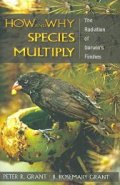
|
|
Fossils, Finches and Fuegians: Charles Darwin's Adventures and Discoveries on the Beagle, 1832-1836Richard Keynes
Harper Collins
2003
"A narrative account of Darwin's historic 4-year voyage on the Beagle to South America, Australia and the Pacific in the 1830s that combines the adventure and excitement of Alan Moorehead's famous account with an expert assessment of the scientific discoveries of that journey. The author is Charles Darwin's great-grandson. In his autobiography, Charles Darwin wrote: 'The voyage of the Beagle has been by far the most important event in my life and has determined my whole career; yet it depended on so small a circumstance as my uncle offering to drive me 30 miles to Shrewsbury, which few uncles would have done, and on such a trifle as the shape of my nose. I have always felt that I owe to the voyage the first real training or education of my mind. I was led to attend closely to several branches of natural history, and thus my powers of observation were improved, though they were already fairly developed. The investigation of the geology of all the places visited was far more important, as reasoning here comes into play.' No biography of Darwin has yet done justice to what the scientific research actually was that occupied Darwin during the voyage. Keynes shows exactly how Darwin's geological researches and his observations on natural history sowed the seeds of his revolutionary theory of evolution, and led to the writing of his great works On the Origin of Species and The Descent of Man."
|
Buy from amazon.co.uk 
|
|
Ecology and Evolution of Darwin's FinchesPeter R. Grant
Princeton University Press
1999 (orig edition 1986)
"After his famous visit to the Galapagos Islands, Darwin speculated that "one might fancy that, from an original paucity of birds in this archipelago, one species had been taken and modified for different ends." This book is the classic account of how much we have since learned about the evolution of these remarkable birds. Based upon over a decade's research, Grant shows how interspecific competition and natural selection act strongly enough on contemporary populations to produce observable and measurable evolutionary change. In this new edition, Grant outlines new discoveries made in the thirteen years since the book's publication. Ecology and Evolution of Darwin's Finches is an extraordinary account of evolution in action."
|
Buy from amazon.co.uk 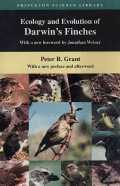
|
|
The Beak of the Finch: A Story of Evolution in Our TimeJonathan Weiner
Alfred A. Knopf
1994
"On a desert island in the heart of the Galapagos archipelago, where Darwin received his first inklings of the theory of evolution, two scientists, Peter and Rosemary Grant, have spent twenty years proving that Darwin did not know the strength of his own theory. For among the finches of Daphne Major, natural selection is neither rare nor slow: it is taking place by the hour, and we can watch. In this dramatic story of groundbreaking scientific research, Jonathan Weiner follows these scientists as they watch Darwin's finches and come up with a new understanding of life itself. The Beak of the Finch is an elegantly written and compelling masterpiece of theory and explication in the tradition of Stephen Jay Gould."
|
Buy from amazon.co.uk 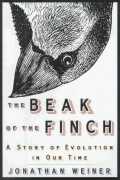

|
|
Evolutionary Dynamics of a Natural Population: The Large Cactus Finch of the GalapagosR. Grant and P. Grant
University of Chicago Press
1989
"Presents a careful account of the results of a research project which began in 1973 and ran continuously for eleven years. Treats the ecology, behavior and genetics of a population still resident where it evolved, and small enough to permit the identification of every individual. Beautifully produced in every respect."
|
Buy from amazon.co.uk 
|
|
Darwin's FinchesDavid Lack
Cambridge University Press
1947 (Reissued 1961 & 1983)
Classic study of the Darwin's Finches of the Galapagos.
|
Buy from amazon.co.uk |
|
The Zoology Of The Voyage Of H.M.S. Beagle
Edited and superintended by Charles Darwin
Part III: Birds
John Gould
Additional text: George Robert Gray, T.C. Eyton and Charles Darwin
Colour plates: John Gould, Elizabeth Gould
Smith Elder and Co
1841
From the Advertisement: "When I presented my collection of Birds to the Zoological Society, Mr. Gould kindly undertook to furnish me with descriptions of the new species and names of those already known. This he has performed, but owing to the hurry, consequent on his departure for Australia, an expedition from which the science of Ornithology will derive such great advantages, he was compelled to leave some part of his manuscript so far incomplete, that without the possibility of personal communication with him, I was left in doubt on some essential points. Mr. George Robert Gray, the ornithological assistant in the Zoological department of the British Museum, has in the most obliging manner undertaken to obviate this difficulty, by furnishing me with information with respect to some parts of the general arrangement, and likewise on that most intricate subject, the knowledge of what species have already been described, and the use of proper generic terms. I shall endeavour in every part of the text to refer to Mr. G. R. Gray's assistance, where I have used it. As some of Mr. Gould's descriptions appeared to me brief, I have enlarged them, but have always endeavoured to retain his specific character; so that, by this means, I trust I shall not throw any obscurity on what he considers the essential character in each case ; but at the same time, I hope, that these additional remarks may render the work more complete. The accompanying illustrations, which are fifty in number, were taken from sketches made by Mr. Gould himself, and executed on stone by Mrs. Gould, with that admirable success, which has attended all her works. They are all of the natural size with the exception of four raptorial birds, a goose and a species of Rhea. As the dimensions of these latter birds are given, their proportional reduction will readily be seen."
|
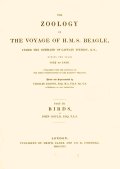
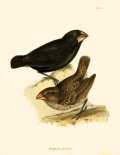
 |
|